The Ultimate Guide for How To Hit A Draw: The Tour Draw, Fix Your Slice
01/23/2016
The draw is the most desired shot in golf. It ranks up there with the gorgeous flop shot and the high, soft fairway wood. Golfers want to learn how to hit a draw at all costs.
But sometimes hitting a draw doesn’t seem easy. Most times, one thing stands in their way–the dreaded slice. It’s pesky. It’s annoying. It is crippling and debilitating for golfers search for a way out. It burdens golfers to continue hitting slices.
Where a draw leaves promise, a slice leaves anguish.
These ugly shots, these nasty slices, veer drastically off course, typically ending in a hazard, tree line or out-of-bounds, that is, if the player doesn’t compensate by aiming 20, 40, or even 50 yards away from their target.
No one is immune from the occasional slice, not even the greatest golfer of a generation.

Slices lose distance and strip a golfer of his main goal, his main conquest, which is more enjoyment of this game.
We want to teach you how to fix a slice. More importantly though, we want to teach you how to hit a draw even with a driver.
Watch this video by PGA teaching professional Todd Kolb and maybe you can identify with his points. Perhaps you have struggled with a slice. No longer!
It’s time to learn how to hit a draw with the Tour Draw.
[bctt tweet=”Where a draw leaves promise, a slice leaves anguish.”]
Let’s explore the slice, first. When we talk about a slice in golf, we aren’t talking about this:
When you slice the ball too much… #Golf #Failhttps://t.co/6z9nT2zWG7
— Golf Escapes (@GolfEscapes) January 8, 2016
When talking about a slice in golf, we’re talking about this, by definition:
slice
slīs
noun
1.
a thin, broad piece of food, such as bread, meat, or cake, cut from a larger portion.
“four slices of bread”
2.
GOLF
a stroke that makes the ball curve away to the right (for a left-handed player, the left), typically inadvertently. Compare with hook.
Take specific note of that second definition.
The first definition may make you hungry for a sandwich, but it’s the second definition here that’s relevant. This is the definition that may make you hungry for better golf shots.
With a ball curving away to the right, golfers will be losing distance, losing accuracy and often times, losing golf balls. This isn’t a way to play the game. Golfing with a slice is not the way to gain maximum enjoyment from golf.
This is what we want:

Old (False) Ball Flight Laws
Before we go where we want to go–which for us, is with better golf shots–we first must understand where we’ve been. How did we get here? What information are we using to try to decipher the path of a golf ball.
Author Terry Pratchett, of I Shall Wear Midnight, had a quote that pertains to the way people seek improvement and a new path in life. He said,
“If you do not know where you come from, then you don’t know where you are, and if you don’t know where you are, then you don’t know where you’re going. And if you don’t know where you’re going, you’re probably going wrong.”
Spanish novelist George Santayana had a quote that was very much the same as Mr. Pratchett’s above. He was blunt when explaining human nature’s lack of understanding. He said the following:
“Those who are unaware of history are destined to repeat it.”
People in golf are constantly looking for a way to fix their game, and to fix it fast.
They’ve tried everything. From strengthening the grip, to turning their shoulders around, to rotating their arms, golfers have finally given up and just started aiming further away from their targets.
This is not good. It will promote even more of a slice.
How many golfers have you heard say, “I just play my slice and aim for it.” Too many to count, in our opinion.
If they are slicing, they are looking for a way to fix it. More times than not, this pursuit of correction is taken impatiently, with haste. Quick fixes have been the demise of many golfers, eroding skills and draining confidence.
In this video below, Todd Kolb explains what the Old Ball Flight laws were and gives a short explanation for what we previously understood in the golf industry.
The old ball flight laws are characterized by two basic elements which determine the direction the ball would travel– the face and the path.
The face was described as the club face and the direction it is pointed at impact. If it is pointed to the left, the ball would move left (remember, these are the “old laws,” not the “new laws”). Conversely, if the face is pointed to the right, the ball would move to the right.
The path was described as the swing path and it was the direction the swing traveled. If the swing traveled to the left, the ball would start to the left and vice versa for the right.
This is what golf instructors were taught for many years.
This has been since, proven to be incorrect.

Along with those “laws” came a set of suggestions. These suggestions have become far too common to hear in the golf industry.
Even ESPN and their segment “Sport Science” found themselves desperate for learning the reason a golf ball travels the way it does.
Just stumbled across this awesome video whilst teaching a client about ball flight laws. Well worth a watch!https://t.co/DNkWBslJPE
— James McDowall (@JamesMcDowallCX) January 16, 2016
The Old (WRONG) Suggestions for Fixing a Slice
When you have poor information, what do you do?
If information given, unbeknownst to you, was incorrect and it was the base for your instruction or practice, what would you do? You would do, what we all do. You would make poor decisions around it.
This is what caused these list of poor suggestions.
In this video below, PGA teaching professional Todd Kolb explains the poor suggestions given to golfers in hopes of fixing the slice.
The old suggestions for fixing a slice were the following:
- Strengthen Your Grip
- Rotate Your Arms
- Close the clubface
Let’s together, dive into each one of these tactics and why they never helped you to fix your slice.
First, strengthening your grip. For those of you unfamiliar with the terminology (sorry, golfers possess some unique jargon), strengthening the grip, or making the grip strong, is the act of turning the top hand more over the top of the golf club. Many instructors refer to it as “revealing more knuckles.”
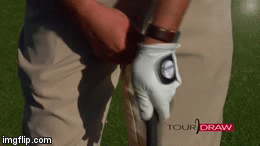
By doing this, you’re giving yourself added control to the club. This is good.
Now don’t get this misconstrued. Having a strong is not a bad thing. In fact, the best players in the world play with a strong grip, or a top hand that covers more of the top of the club. Look at Zach Johnson.
A strong grip gives golfers more control over the club and the ability to create more speed and stability through impact. Having a strong grip is a good thing.
But it will not help you fix your slice.
The reason for it, is because it doesn’t have a direct correlation to what the face and the path are doing.
As Todd pointed out in the video, a strong grip is not a long-term solution for fixing a slice. Maybe you’ll reduce your slice. Maybe you’ll even hit a few draws and hooks in the short-term, but a simple grip change is not the be all end all for fixing a slice.

A second piece of advice many of you have probably heard would be to rotate your arms (or rotate your hands). This is a myth in the world or fixing a slice.
I’m sure you’ve heard it before from amateur swing “experts” on driving ranges around the world.
“Oh, you just need to roll your arms through,” they would say. Maybe it would be a variation, where they would say, “rotate your wrists.”
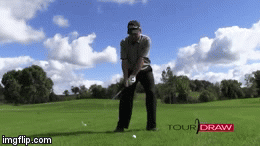
All this information does is accelerate the club head through the impact zone. The club face will go from the square position and through impact without nearly the level of control needed to hit consistent golf shots.
Their intent with offering this insight is to square the club face and “release the club face”, but it is not always the result. Rotating the arms and rolling the wrists will typically results in errant play and poor rhythm.
Do not take this advice.
The third and final piece of advice commonly heard is to close the club face.
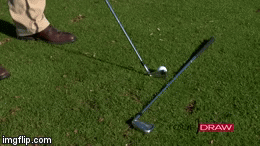
Closing the club face may eliminate the slice, sure, but it’s going to bring along a host of other issues in your golf game.
The club face plays a majority factor in what direction the golf ball starts. If you close the club face, the ball is going to start that direction. Depending on your swing, this will not eliminate your slice.
As you’ll learn, it is the relationship between the face and the path that decides the ball’s flight.
None of this information is meant to hurt your game. It’s probably given to you with good intentions. But know that the way to hitting a draw does not come in any of these three old suggestions.
Here’s how to hit a draw:
The New Ball Flight Laws
So why do you slice the ball? What’s the real reason?
Have you ever wondered if you’ve been given bad information? Maybe information like you were given above?
Bad information in golf–like anything–can have it’s laundry list of consequences. It will cause self-doubt. It will cause poor practice habits. Bad information will cause a general misunderstanding of golf and inhibit golfers from taking that next step in their golf games.
There are new laws in the game of golf. We now know why the golf ball slices.
In the video below, Todd Kolb explains the new laws of ball flight. He explains the proper information for understanding your slice.
As you learned in the video above, there are two factors for why you slice the ball and why the ball shapes the way it does. We know this as an absolute fact.
- The ball starts where the club face points
- The ball curves where the path goes

Got it?
You can test this out while you hit balls. If the ball starts to the left, that would indicate the face was pointed to the left. The opposite is true if the ball starts to the right.
We know based on where the ball starts, what position the face was in.
When the ball starts to curve, we know where the path of the club then traveled. It is important to understand this relationship between face and path when working to properly diagnose your golf swing.
The path will tell the ball how it should curve.
This new information is the correct information you need to understand when evaluating your golf swing. Thanks to the advancements in technology and the improved understanding of the physics, we now understand the flight of the ball better than ever before in history.
This means we can actually fix your slice. We have the correct information!
Now let’s do it!
**************
The New (CORRECT) Suggestions for Fixing a Slice
Now that we understand why the ball curves the way it does, let’s start finding a few key objectives we can focus on as we practice and move forward into a slice free world!
A slice free world, what a wonderful, magical land.
The beauty in understanding the ball flight laws means two things:
- We can stop slicing the ball, and
- We know the laws for slicing the ball, and can still slice one when we need to!
That’s right. As golfers, we’re going to find ourselves behind trees and in unfavorable spots on the golf course (although of course, we hope it’s less often). With our new knowledge, we can apply it and slice the ball for emergency slices. Useful shot mate.

So when we’re looking to properly fix a slice, there are suggestions that can have a positive impact on your quest. With this new knowledge, we know there are many things we can do to turn slices into draws, so here are a few we focused on.
- Work with the lead hip
- Work with the lead arm
- Work with your trail knee
- Work with the handle of the golf club
Todd Kolb explains them generally in this video below with the new suggestions for fixing your slice.
Understanding these elements of the golf swing will start to help you better control that slice you’ve been dealing with forever.
You’ve probably never spent much time working with your lead hip or looking more into the path of the handle when you’re swinging the golf club.
Next time you’re practicing, take note of these parts of your body. Start to get your feels in these areas.
Doing so will help you have a familiar idea when it comes time to start fixing a slice.
To learn more about these areas, click on the graphic below and consider working with the Tour Draw.
Left Arm High, Right Arm Low

Let’s make sure the left arm is high and the right arm is low.
This is one of the first areas to address when looking to correct your slice.
It’s not that executing certain things directly fix your slice, but practicing these elements will start to change the path the club travels.
By influencing the path of the club, the ball flight will begin to change. That’s right, the slice is a thing of the past (well, not yet–still have a lot of driving range practice with these new tools!).
Watch the video below, where PGA teaching professional Todd Kolb starts to explain what the “Left Arm High, Right Arm Low” means:
When you’re looking at executing this in your swing, you may find yourself confused on exactly what this means. What does “left arm high” mean? Where does the left arm need to be higher?
In fact, it’s important to know this means from down the line (or behind the golfer). See?
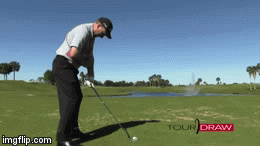
Also, if you’re a left-handed golfer, just know that you need to do the opposite. This would be better called “Right Arm High, Left Arm Low.”
The reason you should be conscientious of where the left arm is located during the swing, is because it will help control the direction the club will travel. You’ll be reseting the plane and promoting a path that moves from the inside (closer to the body) and moves outside (further away from the body).
There’s that path!
A draw…
Spieth loves it.

Left Hip Left
This is a very slight change to make to a golf swing, but it may take the most getting used to and gaining comfortability. With this change, you’re moving the weight during the swing and drastically changing the path the club will travel.
It may feel like the weight is stacked a bit, which it is, but don’t let it inhibit you from swinging naturally and allowing your body to move freely. If this move causes rigidity, it will not allow for what’s necessary to take place. Fluidity in the golf swing is key.
Let’s take a look at how simple the “Left Hip Left” is:
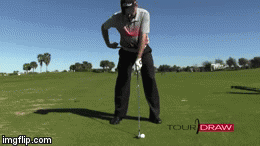
Getting the “Left Hip Left,” similar to the drill above (left arm high) is an adjustment to made during the set-up. All of this takes place before the club starts it’s takeaway.
With this drill, Todd Kolb explains below how to perform this simple change and generally explains what it does for the golfer.
Naturally when moving the hip to the left, the right leg is going to straighten a bit as well. With this move, it’s much harder to pull the club back to the inside (toward the body). The club naturally wants to travel out, which helps promote and awesome club path.
Left hip left, baby and start to see that draw!
See, even the PGA Tour players get that left hip moving left, look at Tour veteran Matt Kuchar!
Kuchar birdied his final six holes today for a 62.
He made putts from:
• 30 ft
• 6 ft
• 7 ft
• 15 ft
• 5 ft
• 4 ft pic.twitter.com/2Wdaz7MrCI— PGA TOUR (@PGATOUR) January 17, 2016
Raise the Handle
The final tip we’re going to offer here to help you start hitting those gorgeous draws is to raise the handle of the golf club.
When you hear us say “raise the handle,” you need to eliminate any thoughts of Chi Chi Rodriguez and the way he used the handle of a golf club. This is not what we mean!

Remember what ended up happening to Chi Chi?

Now stay focused. Chi Chi can be enough to distract any golf loving person, but we’re here to work on hitting draws and eliminating the slice (although those GIFs are good for a laugh).
When you hear “raise the handle,” this is another simply adjustment to be made at address. It’s simply to raise the handle of the golf club.
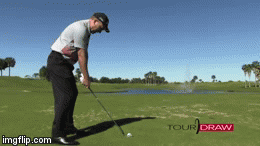
Todd Kolb explains the tip in this video below:
As you can see, raising the handle of the golf club can, and will, change the path your club travels. It will help change the plane the golf club needs to move on and help it to move outward, a key necessity for getting that wonderful draw.
Note, it’s not enough to just raise the handle.
We also want to see you move that handle to cover the golf ball–moving it left. And when you swing the club, keep that handle high throughout the swing.
Doing this helps promote, again, the path moving to the right. With a square club face, a golfer swing this way will start to see their ball drawing!
Another absolute key to this drill is keeping your arms tension free.
Tension is an absolute killer in the golf swing.
Take it from the legend Bobby Jones.

He understood it. And it’s important you do, too.
For great tips on how to relieve tension, consider reading any number of the great golf psychology books available.
Playing golf with tension is no way to enjoy the game. It’s certainly no way to hit a draw.
Byron Nelson may have said it best with his simplicity.

Conclusion
With all of the tips included in this blog, you’re on your way to better golf. You’ll put to rest the slices of your past and move forward into a world of beautiful draws– Tour Draws!
We have this information and so much more at www.yourtourdraw.com. We unveil more secrets and dive in-depth, explaining everything you need to know to change your golf game forever.
The tips included in this blog are hopefully enough to help you reconsider what you’ve learned about fixing your slice in the past.
It’s now time to move forward with a draw. A Tour Draw.
Again, for more information, we encourage you to look into joining us at www.yourtourdraw.com (or by clicking the box below, along with any of the boxes throughout this blog).
We’ve changed the games of many golfers, and we know we can help you change your game, too.
Thanks for joining us, and good luck hitting the draw. #TourDraw


Really like how you guys lay these articles out. Second time on your site, but first real deep dive into it. Really enjoy the use of visuals down your articles and the volume of relevant/current and intriguing content. Very interesting look into a bunch of different parts of the world of golf. Really like what you guys do on here and how your doing it.
Tyler Simpson
Tathata Golf
Tyler
Thank you so much for the comment. We work really hard to deliver great content and to hear compliments like this really mean the world to our team. I’ll pass your regards on to everyone.
Much appreciated, Tyler. Wishing you and everyone at Tathata Golf an excellent 2016. Looking forward to the continued relationship.
— Troy
Thanks
You’re welcome Mike. We hope it helps.